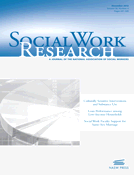-
Views
-
Cite
Cite
Maria Cancian, Jennifer L. Noyes, Marci Ybarra, The Extended TANF Application Period and Applicant Outcomes: Evidence from Wisconsin, Social Work Research, Volume 36, Issue 4, December 2012, Pages 273–288, https://doi.org/10.1093/swr/svs054
Close - Share Icon Share
Abstract
This article examines the characteristics and income patterns associated with welfare entry and nonentry in the context of an extended application period for a sample of 1,664 women who applied for Temporary Assistance for Needy Families services in Wisconsin in the fall of 2006. The study uses data derived from the systematic review of caseworker notes as well as administrative data on welfare participation, earnings, child support, the Supplemental Nutrition Assistance Program, Earned Income Tax Credit estimates, and Supplemental Security Income receipt. It finds that about one-half of those who applied for services did not enter the welfare program within a 60-day time frame. Results indicate that those with consistent employment prior to applying for services, those with very young children, and pregnant applicants are less likely to drop out. In examining differences in economic well-being in the year following an application, the study finds that those who applied for and entered welfare (participants) and those who applied for but did not enter (dropouts) generally had similarly high levels of poverty. However, dropouts had higher rates of deep poverty, with some subgroups—such as those who had declined services—faring better than others.





